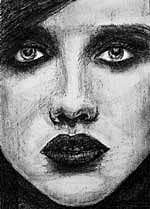Understanding the power of line

It stood out among many works — most of them colourful paintings. The artist has depicted an attractive woman’s face using pen and ink method. He has employed the cross hatching technique reminiscent of classic printmaking application to denote the shaded areas. Thin fine lines are methodically applied to bring about tonal variations in which the artist seems to have succeeded very well. Though moderate in size, this work on paper has achieved a quality that is seldom brought about even in a painting.
Despite her misgivings on the price, this connoisseur seems to have liked the work. She kept coming back to look at it. The lure of a good work.
Many occasions I have experienced people expressing their hesitation to buy a drawing, because it simply happened to be ‘just a drawing’. This doesn’t seems to be a an Indian phenomena. It is a universal one, when it comes to the price of a drawing. I think the whole confusion has been generated by the attitude of artists themselves. Artists seldom think their drawings are equal to the paintings they create. Such attitude is the result of the enormous amount of work that goes into the making of a painting or sculpture, comparatively. Most artists prepare preliminary drawings as a preparatory act to their paintings, sculptures or other works. They range from thump nail idea sketches to enlarged final drawings to be transferred to a large canvas or to a wall as a guide for the finished work. Many artists do several studies of objects or people before they actually attempt a painting. This is actually a system developed by artists. Though it might have been a practice every where, European masters seems to have perfected it.
It is true numerous preliminary scribbles, sketches and studies have to be done by an artist as a an initial exercise to create a great work of art. It is like writers making notes and planning plots before attempting a work that would sometimes run into thousands of pages. These notes work as guide to control the writers imaginations and route them in the right direction to achieve the intended result.
While these preliminaries are used as a support and guide for a final version of a work there are many drawings that has been created by artists that results as a completed version of their thoughts and imagination. It may be created by an artist by a momentary inspirational thought and imagination. Or a planned study in its entirety and a final version of the process. Artists have many preferred ways of doing these drawings. Some like to work from purely imaginative concepts and others would sit and create a drawing of a person or an object witnessed at the moment. Some do series of drawings based on a particular theme with the same intensity and creative effort as a large series of paintings demand.
I remember a work I saw in the Cleveland Museum of Art. It is a small work — about 10 inches high — by the 16th century Italian artist Pietro Perugino. It is a drawing of St Sebastian in silver point and brown ink. It is very craft oriented and the artist has used the flow of line at its best effect. May be a preliminary study for a painting later; this work evokes a feeling even a finished painting of the same subject may not. It is the pure power of line that exudes such strength and aesthetic feeling.
I am a great admirer of late Adimoolam’s drawings. In his early days, Adi was more known for his drawings than paintings. His series that deals with space and form done in pen and ink is very powerful. Probably his later abstract colour oriented works are derived from these.
But when I look back at those works I get the feeling that the strength of the drawing is missing in his abstracts, though it compensates with the exuberance of the colours. His series of drawings depicting the kings, queens, commoners and deities are pure delights in line.
An important series of works from this master of line is the one he did on Mahatma Gandhi. Thousands of artists across the world has depicted Mahatmaji in many forms of art. Countless sculptures , paintings and drawings have been created in homage to Gandhiji. Among them Adimoolam’s drawings stand apart for their simplicity and purity of lines which echoes the same traits the great mahatma’s name and personality embodies.
There is a fairly large drawing titled ‘Gandhiji in relaxed mood’ which is a masterpiece among the series itself. Adimoolam has used cross hatching technique to define the forms in this work that gives it considerable depth and content. But in its entirety this drawing is indeed a creation that has achieved a perfection comparable to any other great works of the same subject.
When it comes to drawings no discussion would be complete without a mention of the free-flowing silky lines of KK Hebbar. I am fortunate enough to witness him drawing on several occasions. I always noticed his calm demeanour while that wiry hand went on creating those legendary lines in a seemingly easy pace. But a perfectionist’s struggle behind those lines are evident.
Here is an artist who demonstrates that a simple line at times could become far more superior to a colourful and elaborately executed painting.
(The writer is a well-known artist)
Deccan Herald is on WhatsApp Channels| Join now for Breaking News & Editor's Picks